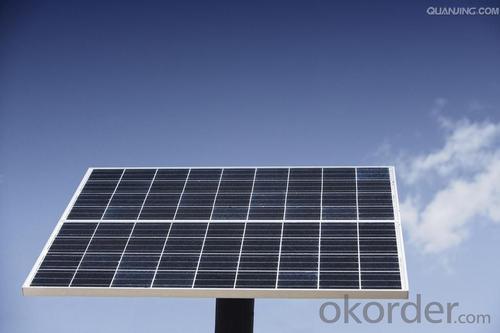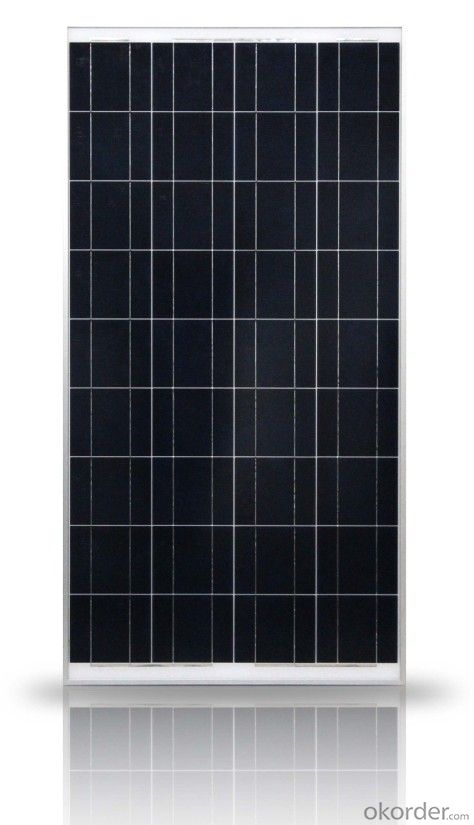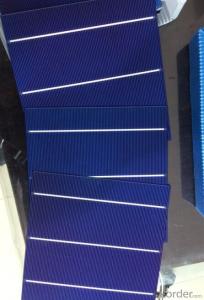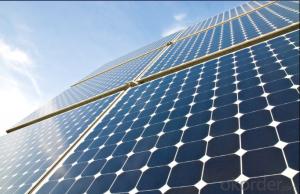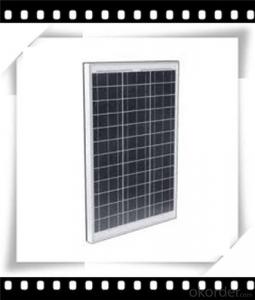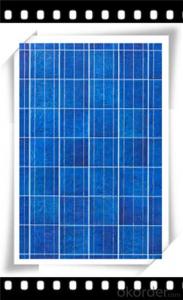Individual Solar Cells - High Efficiency Poly Solar Panel Hot Sale CNBM
- Loading Port:
- Qingdao
- Payment Terms:
- TT OR LC
- Min Order Qty:
- 10 set
- Supply Capability:
- 300000 set/month
OKorder Service Pledge
OKorder Financial Service
You Might Also Like
Polycrystalline Solar Modules
CNBM offers a range of small, medium and large polycrystalline solar modules, designed for a range of requirements.
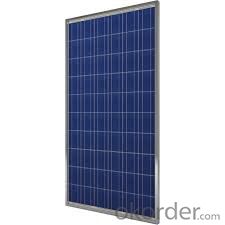
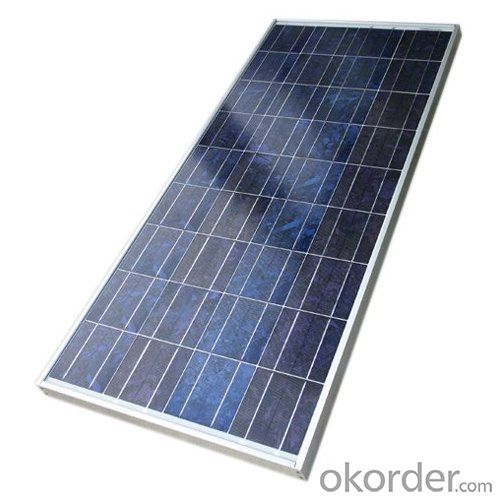
Specifications:
Tolerance | +/-3% |
Cell | Polycrystalline silicon solar cells (156 x 156mm) |
N0. of Cells | 60 (10 x 6) |
Dimension of Modules (mm) | 1650 x 990 x 40 |
Weight (kg) | 25.5 |
Limits:
Operating Temperature | -40~+85? |
Storage Temperature | -40~+85? |
Maximum System Voltage | 1000 VDC max. |
Hail Impact | Diameter of 28mm with impact speed |
Temperature and Coefficients:
NOCT | 48C+/-2? |
Voltage temperature coefficient (%/K) | -0.35 |
Current temperature coefficient (%/K) | 0.05 |
Power temperature coefficient (%/K) | -0.45 |
Characteristics:
Model: | SGM-200P | SGM-210P | SGM-220P |
Max-power voltage Vmp (V) | 29.2 | 29.4 | 29.41 |
Max-power current Imp (A) | 6.85 | 7.14 | 7.48 |
Open-circuit voltage Voc (V) | 36.5 | 36.69 | 36.9 |
Short-Circuit Current Isc (A) | 7.28 | 7.6 | 7.93 |
Max-power Pm(W) | 200 | 210 | 220 |
Model: | SGM-230P |
Max-power voltage Vmp (V) | 29.8 |
Max-power current Imp (A) | 7.72 |
Open-circuit voltage Voc (V) | 37.31 |
Short-Circuit Current Isc (A) | 8.19 |
Max-power Pm(W) | 230 |
STC: Irradiance 1000W/m2, module temperature 25?, AM-=1.5
Poly Crystalline Solar Panels Specifications Range
Maximum Power (Pm) | Dimension | Weight | Operating Voltage (Vmp) | Operating Current (Imp) | Open Circuit Voltage (Voc) | Short Circuit Current (Isc) |
0.45W | 140x80x10mm | 0.08kg | 3.3V | 150mA | 4.6V | 160mA |
1.0W | 162x140x10mm | 0.16kg | 7.5V | 150mA | 10.3V | 160mA |
4.5W | 269x251x23mm | 0.8kg | 16.5V | 0.27A | 20.5V | 0.3A |
10W | 420.1×268.9×22.6mm | 1.92kg | 17.5V | 0.58A | 20.5V | 0.6A |
20W | 425x502x50mm | 3.0kg | 16.8V | 1.19A | 21.0V | 1.29A |
30W | 593x502x22.6mm | 3.9kg | 16.8V | 1.78A | 21.0V | 1.94A |
40W | 655x537x50mm | 5.75kg | 17.3V | 2.31A | 22.1V | 2.54A |
50W | 839x537x50mm | 6.0kg | 17.5V | 2.9A | 21.8V | 3.17A |
65W | 1111x502x50mm | 7.2kg | 17.6V | 3.69A | 22.1V | 3.99A |
80W | 1204x537x50mm | 7.7kg | 17.6V | 4.55A | 22.1V | 4.8A |
- Q: How do solar cells impact greenhouse gas emissions?
- Solar cells have a significant positive impact on greenhouse gas emissions as they generate electricity without producing any greenhouse gases. The use of solar energy reduces our reliance on fossil fuels, which are major contributors to greenhouse gas emissions, thereby helping to mitigate climate change.
- Q: What is the impact of fire hazards on solar cells?
- Fire hazards can have a significant impact on solar cells, as they are highly susceptible to damage and destruction when exposed to fire. The extreme heat generated by fires can melt or deform the delicate components of solar cells, rendering them useless. Additionally, smoke and soot particles can accumulate on the surface of solar panels, reducing their efficiency by blocking sunlight. Therefore, fire hazards pose a serious threat to the functionality and lifespan of solar cells.
- Q: How do solar cells perform in areas with high levels of air pollution?
- Solar cells perform less efficiently in areas with high levels of air pollution. Air pollution, especially particulate matter and smog, can block sunlight and reduce the amount of light reaching the solar cells. This reduces their ability to generate electricity and can significantly decrease their performance. Additionally, air pollution can settle on the surface of the solar panels, creating a layer of dirt or dust that further reduces their efficiency. Regular cleaning and maintenance are required to ensure optimal performance in such areas.
- Q: Can solar cells be used in areas with high humidity?
- Yes, solar cells can be used in areas with high humidity. While high humidity can potentially affect the overall efficiency of solar cells, advancements in technology and materials have made them more resistant to moisture and corrosion. Additionally, solar panels are designed to withstand various weather conditions, including high humidity, and continue to generate electricity even in such environments.
- Q: Can solar cells be used on road surfaces?
- Yes, solar cells can be used on road surfaces. Solar road technology, also known as solar roadways, involves embedding solar panels into roadways to generate electricity. These solar panels are designed to withstand the weight of vehicles and can be used to power streetlights, traffic signals, and even electric vehicles. However, there are challenges to overcome, such as durability and cost-effectiveness, before widespread implementation can occur.
- Q: What is the impact of bird droppings on solar cell efficiency?
- Bird droppings can have a negative impact on solar cell efficiency as they can block sunlight from reaching the surface of the cells, reducing their ability to generate electricity. Additionally, the acidic nature of bird droppings can cause damage to the protective coatings on the solar cells, further decreasing their efficiency. Regular cleaning and maintenance are necessary to mitigate the effects of bird droppings on solar cell performance.
- Q: How do solar cells perform in high-altitude locations?
- Solar cells perform well in high-altitude locations due to several factors. Firstly, at higher altitudes, there is often less air pollution and cloud cover, leading to more sunlight reaching the solar cells. Additionally, the thinner atmosphere at high altitudes allows for a higher concentration of solar radiation, resulting in increased energy generation. Finally, the cooler temperatures at higher altitudes can actually improve the efficiency of solar cells, as they tend to perform better in lower temperatures. Overall, solar cells are highly effective in high-altitude locations, making them an ideal renewable energy solution in such areas.
- Q: Does solar cell cost less than the other power generation technology?
- It cost more to build the solar cell because it requires more research and technology, but it won't cost much in long term.
- Q: Can solar cells be used in theme parks?
- Yes, solar cells can be used in theme parks. Solar panels can be installed in theme parks to generate electricity from sunlight, which can be used to power various attractions, lighting, and other electrical needs within the park. This not only helps reduce the environmental impact of the park but also provides a sustainable and cost-effective energy solution.
- Q: What factors affect the output of a solar cell?
- Several factors can affect the output of a solar cell. The efficiency of the solar cell is influenced by the intensity and duration of sunlight, as well as the angle at which the sunlight strikes the cell. The quality and cleanliness of the solar cell's surface, the type and quality of materials used, and the temperature can also impact its output. Additionally, external factors like shading, dust, and environmental conditions can affect the performance of a solar cell.
Send your message to us
Individual Solar Cells - High Efficiency Poly Solar Panel Hot Sale CNBM
- Loading Port:
- Qingdao
- Payment Terms:
- TT OR LC
- Min Order Qty:
- 10 set
- Supply Capability:
- 300000 set/month
OKorder Service Pledge
OKorder Financial Service
Similar products
Hot products
Hot Searches
Related keywords


